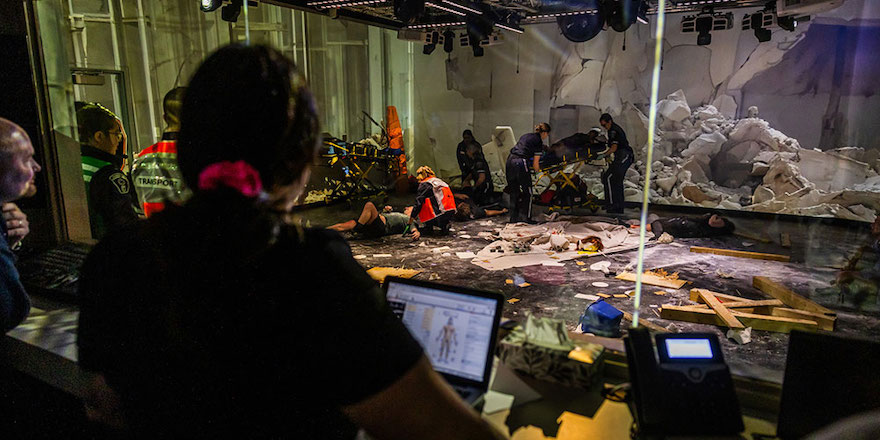NAIT Holds First Student-Designed and Led Health-Care Simulation
Staged crisis featuring live actors, multimedia, and high stress focuses on communication and collaboration amongst NAIT students.

Sirens wail. Odors of smoke and gasoline hang in the air. The ground is slippery with dust and littered with shattered glass, wood, broken merchandise, and paper coffee cups. Where a mall stood minutes ago, there’s now only rubble — a scene projected on every wall of the room.
This is the immersion theatre on a March afternoon at NAIT’s Centre for Advanced Medical Simulation (CAMS). Once the simulation about to take place began in full, the room was populated with actors playing victims and students coming to their aid, triaging, and transporting them to nearby hospital rooms and other amenities designed for staging scenarios that, throughout the year, test skills in safe, controlled environments.
NAIT creates mass-casualty simulation
But this exercise, called CommuniCare 2024, was unique. For the first time, the idea — to improve communication and collaboration across the health-care disciplines responding to a mass-casualty incident — came from a student. In another first, it was designed by Disaster and Emergency Management students.
That dust might have been baby powder, and the smells commercially made concentrates, but the goal was very real, with a potentially profound impact on the province.
“One of the leading causes of errors or harm in health care is a breakdown in communication,” said Lisa George (Bachelor of Technology ’18, Combined Laboratory and X-ray ’09), Combined Laboratory and X-ray chair and lead for the School of Health and Life Sciences interprofessional health education programming.
Hence the need for the biggest simulation event in NAIT’s history, involving roughly 60 students and staff. While the risks in the sim theatre are low, the stakes out in the world are high.
“We know that this is a huge part of what students need to be able to practice before they are actually caring for patients,” said George.
Simulation designed by Disaster and Emergency management students
The inspiration for CommuniCare came a month into the 2023-24 academic year. George visited an Advanced Care Paramedic class to explain the concept of interprofessional education, or learning to successfully work as a team of disparate practitioners. She invited possible scenarios for simulations. “One of the students did take me up on that,” she said.
Carter Buchanan (Primary Care Paramedic ’22, Management ’17) suggested an event to help paramedics understand the language of X-ray, respiratory, medical lab and other technologists, and vice versa.
“We're very much siloed into our own groups,” said Buchanan. With a background in simulation himself, he knew it was possible to address those barriers at the polytechnic. “NAIT is a world-class simulation facility. Some of what we have at our school is next to none.”
To put that facility to work, George reached out to School of Health and Life Sciences colleague Jodi Manz-Henezi, chair of Disaster and Emergency Management (DEM).
“Exercise design is one of the things that we do, including mass casualty incidents,” said Manz-Henezi. It’s part of the program's focus on preparation, building resilience and ultimately mitigating crises. The chair approached students about taking on the extracurricular project.
“I love exercise writing,” said Tamara Rose, a Regina-based student of the program, which is delivered online. Rose considered CommuniCare work experience. “It was another tool under the belt that I could put on my resumé.” (She even drove to Edmonton to participate on site.)
Rose and four colleagues (including Montreal-based student Mathieu Martel, who named the event), designed the disaster in consultation with students and staff. Their precision and level of detail set a precedent for simulation at NAIT, suggested CAMS simulation technologist Tom Waring. So did with their role in coordinating the event.
From a data visualization lab across campus — essentially mission control, complete with monitors showing every room in the exercise — the team moved the simulation forward, or in unexpected directions, by queuing “injects” of actors and plot twists (a distraught mother, for example, disrupting a child’s medical intervention).
Their involvement, “means that we can have more complex cases because we have that structure in place,” said Waring. “It's very valuable training for the students.” It also creates a valuable opportunity to fail, as pointed out by Buchanan’s classmate Trenton L’Ecluse, who worked with the DEM team to describe patients and treatment paths.
“I 100% expect that there's going to be multiple communication breakdowns [during the simulation],” said L’Ecluse. He welcomed them. “It gives everyone that chance to reflect on where things can be improved.”
Talking as technique
Communication is a widely recognized area of concern in health care. “Different backgrounds can contribute to professional culture clash, which can impair team performance,” reports one 2021 study. “Communication among clinicians about the care of the critically injured patient frequently breaks down and leads to poor outcomes.”
Events like CommuniCare may help change that by equipping young professionals with skills they need to avoid clashes at the outset. “Starting that right from the beginning of the education process really sets everything up for long-term success,” said L’Ecluse.
While other simulations will help students nail an intubation or perfectly position a patient for X-ray, the inaugural CommuniCare prioritized talking over technique. George hopes to see that continue in the years to come, employing the meticulousness of DEM students, creativity of simulation techs, collaboration of instructors, and the ingenuity of students.
So does Buchanan. When on shift in the ambulance, Buchanan would tell new recruits that what they were about to experience is nothing like school. Thanks to having “world-class facilities” at hand, he may be playing a role scaling back that warning. With the right resources, the lines between training and reality might be effectively blurred.
“When the students who participate in this scenario enter into those situations in real life, they're going to be more prepared,” he said. “And hopefully their patient outcomes will be a reflection of that.”
Learn more about NAIT’s Centre for Advanced Medical Simulation